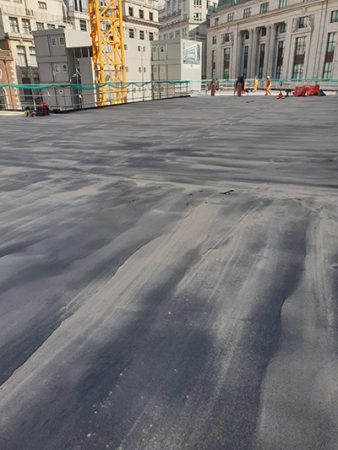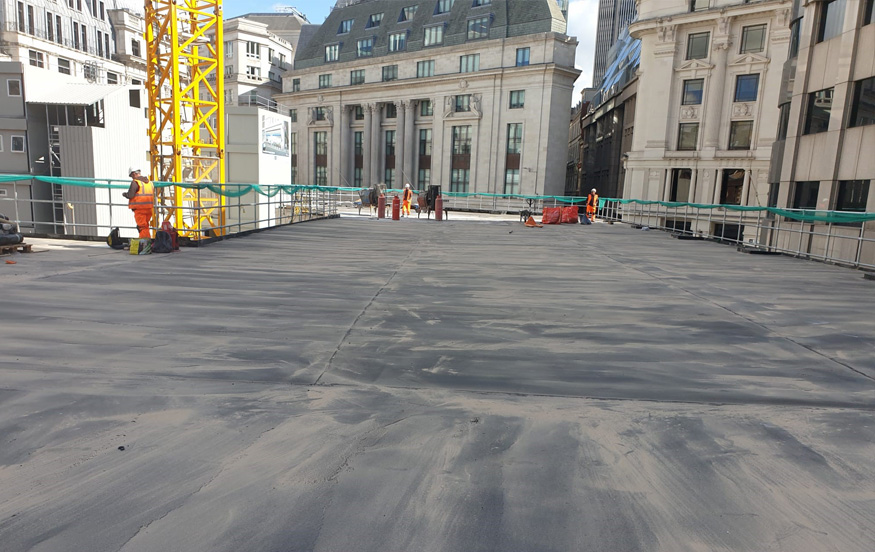One of the award-winning projects at the latest Mastic Asphalt Council (MAC) awards was a project undertaken by MAC contractor member Guaranteed Asphalt at the newly upgraded Bank Underground Station.
Over 1,000m2 of mastic asphalt was used for waterproofing at Bank Station – a project which was deemed so impressive it was declared winner of the ‘Best Development and Hybrid’ project at the MAC awards.
Improvements at Bank Station are part of plans to build a better, safer and more prosperous capital city, with a modern, accessible station in the heart of London. There is a new interchange route making moving around the station quicker, with journey times nine minutes quicker as a result. The upgrade will see the station’s capacity increased by 40% and the structure upgraded into a modern, flagship gateway to London’s financial centre.
 Much of the work completed on the upgrade of Bank Station has been intricate and complicated, with 31 listed buildings at street level above new tunnels, and foundations for other buildings that had to be tunnelled through. The work was completed by teams of engineers working in shifts around the clock. In order to carry out the upgrade, a plot of land occupied by an old office block was cleared and an office and retail block was built above Bank Station’s new Cannon Street entrance, with external terraces and a green roof.
Much of the work completed on the upgrade of Bank Station has been intricate and complicated, with 31 listed buildings at street level above new tunnels, and foundations for other buildings that had to be tunnelled through. The work was completed by teams of engineers working in shifts around the clock. In order to carry out the upgrade, a plot of land occupied by an old office block was cleared and an office and retail block was built above Bank Station’s new Cannon Street entrance, with external terraces and a green roof.
The waterproofing was carried out on the structure at Cannon Street and involved the delivery of 600 tonnes of mastic asphalt at Bank Station in the City of London. To reduce local congestion, the City of London imposes certain restrictions on the number of vehicle making deliveries in the area. The application involved 120mm mastic asphalt and 10-300mm mastic asphalt screed to falls (1 in 60) with a 20mm waterproofing layer.
The screed provides support to the subsequent mastic asphalt application and can be purpose designed for applications ranging from roofing to balconies and access walkways. It can be specified in the majority of cases falling to minimum thicknesses of 10mm, whereas traditional sand/cement and lightweight screeds require a minimum thickness of 50mm.
For this project, the mastic asphalt was specified with future uses in mind. For residential flats being constructed in 10 years’ time, the client wanted to eventually remove the waterproofing and screeding to falls, leaving the mastic asphalt system down to act as the floors for the flats.
A challenge was that mastic asphalt screed had to match the sand/cement screed originally specified, which was 120mm thick, therefore laying the area in three coats. Another challenge was separating the surface from the mastic asphalt screed, which ranged from 10mm to 300mm due to the 1 in 60 falls required.
Mastic asphalt can be laid very swiftly. One 18 tonne hot charge delivery vehicle can supply sufficient mastic asphalt to cover 360m2 of material to a depth of 20mm, which can be laid and finished in a matter of hours. This makes it particularly suitable for larger roofs where it can be applied over in-situ or precast concrete, timber or metal decking. Roofs can be quickly and efficiently waterproofed allowing other trades on site, often within hours. The flowing characteristics of mastic asphalt make it easy for installing contractors to tackle roof surfaces which are complex, stepped or with multiple protrusions.
Mastic asphalt is one of the few construction activities still regarded as a ‘craft trade’. The skilled work involves ensuring that asphalt is at the correct temperature, and then spreading it using traditional techniques to coat the surface. A thermoplastic material that changes shape when heated, mastic asphalt cures to form a hard, durable, finished product to suit all applications of mastic asphalt. To maintain the industry’s reputation and ensure high quality applications for every single project, only trained applicators are permitted to install mastic asphalt under the Mastic Asphalt Council’s strict rules.
Being a MAC member enhances the reputation of a contractor and gives a badge of quality and assurance that they meet very highest of standards with regards to factors such as trading and credit history, insurance policies and quality of workmanship.
The Building Research Establishment (BRE) has officially stated that mastic asphalt is capable of lasting 50-60 years, but the Mastic Asphalt Council (MAC) has many examples well in excess of this. For instance, mastic asphalt was first laid at London’s St Paul’s Cathedral in 1906 and it provided well over 100 years’ of effective waterproofing before it needed replacement.
This article featured within the January 2023 edition of RCi magazine – click here to view the article.

